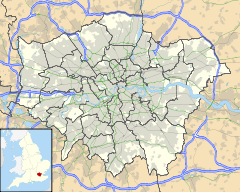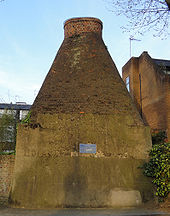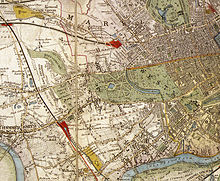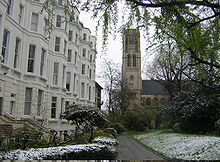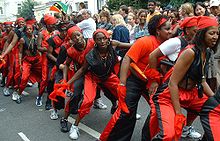- Notting Hill
-
For the film, see Notting Hill (film). For Notting Hill in Melbourne, Australia, see Notting Hill, Victoria.
Coordinates: 51°30′35″N 0°12′15″W / 51.5096°N 0.2043°W
Notting Hill 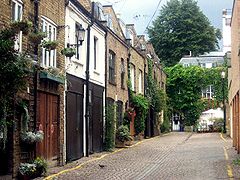
Notting Hill
 Notting Hill shown within Greater London
Notting Hill shown within Greater LondonOS grid reference TQ245805 London borough Kensington & Chelsea Ceremonial county Greater London Region London Country England Sovereign state United Kingdom Post town LONDON Postcode district W11 & W10 Dialling code 020 Police Metropolitan Fire London Ambulance London EU Parliament London London Assembly West Central List of places: UK • England • London Notting Hill is an area in London, England, close to the north-western corner of Kensington Gardens, in the Royal Borough of Kensington and Chelsea. It is a cosmopolitan district known as the location for the annual Notting Hill Carnival, and for being home to the Portobello Road Market.[1]
Notting Hill has a contemporary reputation as an affluent and fashionable area;[2] known for attractive terraces of large Victorian townhouses, and high-end shopping and restaurants (particularly around Westbourne Grove and Clarendon Cross). A Daily Telegraph article in 2004 used the phrase the 'Notting Hill Set'[3] to refer to a group of emerging Conservative politicians, such as David Cameron and George Osborne, now respectively Prime Minister and Chancellor of the Exchequer. However, the large houses have also provided multi-occupancy rentals for much of the 20th century. Caribbean immigrants were drawn to the area in the 1950s, partly because of the dubious practices followed by the landlord Peter Rachman, and became the target of white Teddy Boys in the 1958 Notting Hill race riots.
Notting Hill has had an association with artists and "alternative" culture since its development in the 1820s.[4][5] There are also areas of deprivation to the north,[6] sometimes referred to as North Kensington, or Ladbroke Grove, from the name of the street.
Contents
History
Origin of the Notting Hill name
The origin of the name "Notting Hill" is uncertain[7] though an early version appears in the Patent Rolls of 1356 as Knottynghull,[8][9] while an 1878 text, Old and New London, reports that the name derives from a manor in Kensington called "Knotting-Bernes,", "Knutting-Barnes," or "Nutting-barns",[5] and goes on to quote from a court record during Henry VIII's reign that "the manor called Notingbarons, alias Kensington, in the parish of Paddington, was held of the Abbot of Westminster." For years, it was thought to be a link with Canute, but it is now thought likely that the "Nott" section of the name is derived from the Saxon personal name Cnotta,[10] with the "ing" part generally accepted as coming from the Saxon for a group or settlement of people.[11]
Potteries and Piggeries
Main article: Pottery LaneThe area in the west around Pottery Lane was used in the early nineteenth century for making bricks and tiles out of the heavy clay dug in the area. The clay was shaped and fired in a series of brick and tile kilns.[12] The only remaining nineteenth-century tile kiln in London is on Walmer Road.[13] In the same area, pig farmers moved in after being forced out of the Marble Arch area. Avondale Park was created in 1892 out of a former area of pig slurry called 'the Ocean'. This was part of a general clean-up of the area which had become known as the Potteries and Piggeries.
19th century development
Main article: Ladbroke EstateThe area remained rural until the westward expansion of London reached Bayswater in the early 19th century. The main landowner in Notting Hill was the Ladbroke family, and from the 1820s James Weller Ladbroke began to undertake the development of the Ladbroke Estate. Working with the architect and surveyor Thomas Allason, Ladbroke began to lay out streets and houses, with a view to turning the area into a fashionable suburb of the capital (although the development did not get seriously under way until the 1840s). Many of these streets bear the Ladbroke name, including Ladbroke Grove, the main north-south axis of the area, and Ladbroke Square, the largest private garden square in London.
The original idea was to call the district Kensington Park, and other roads (notably Kensington Park Road and Kensington Park Gardens) are reminders of this. The local telephone prefix 7727 (originally 727) is based on the old telephone exchange name of PARk.[14]
Ladbroke left the actual business of developing his land to the firm of City solicitors, Smith, Bayley (known as Bayley and Janson after 1836), who worked with Allason to develop the property. In 1823 Allason completed a plan for the layout of the main portion of the estate. This marks the genesis of his most enduring idea – the creation of large private communal gardens, originally known as "pleasure grounds", or "paddocks", enclosed by terraces and/or crescents of houses.
Instead of houses being set around a garden square, separated from it by a road, Allason's houses would have direct access to a secluded communal garden in the rear, to which people on the street did not have access and generally could not see. To this day these communal garden squares continue to provide the area with much of its attraction for the wealthiest householders.[15]
In 1837 the Hippodrome racecourse was laid out.[16] The racecourse ran around the hill, and bystanders were expected to watch from the summit of the hill. However, the venture was not a success, in part due to a public right of way which traversed the course, and in part due to the heavy clay of the neighbourhood which caused it to become waterlogged. The Hippodrome closed in 1841, after which development resumed and houses were built on the site. The crescent-shaped roads that circumvent the hill, such as Blenheim Crescent, Elgin Crescent, Stanley Crescent, Cornwall Crescent, and Landsdowne Crescent, were built over the circular racecourse tracks. At the summit of hill stands the elegant St John's church, built in 1845 in the early English style, and which formed the centrepiece of the Ladbroke Estate development.
The Notting Hill houses were large, but they did not immediately succeed in enticing the very richest Londoners, who tended to live closer to the centre of London in Mayfair or Belgravia. The houses appealed to the upper middle class, who could live there in Belgravia style at lower prices. In the opening chapter of John Galsworthy's Forsyte Saga novels, he housed the Nicholas Forsytes "in Ladbroke Grove, a spacious abode and a great bargain".[17] In 1862 Thomas Hardy left Dorchester for London to work with architect Arthur Blomfield. During this period he lived in Westbourne Park Villas. He immersed himself in the city's literary and cultural life, studying art, visiting the National Gallery, attending the theatre, and writing prose and poetry. His first published story "How I Built Myself A House" appeared in Chamber's Journal in 1865. Here he wrote his first―but never published―novel The Poor Man and the Lady in 1867, and the poem "A Young Man's Exhortation," from which Graham Greene took an epigraph for his own novel, The Comedians. Arthur Machen (1863–1947), the author of many supernatural and fantastic fictions, lived at 23 Clarendon Road, Notting Hill Gate, in the 1880s. He writes of his life here in his memoirs, Far Off Things (1922) and Things Near and Far (1923). His mystical work The Hill of Dreams (1907; though written ten years earlier) has scenes set in Notting Hill. It is here that the protagonist Lucian Taylor encounters the beautiful bronze-haired prostitute who will later connive at his death.
Early to mid-20th century
The reputation of the district altered over the course of the 20th century. As middle class households ceased to employ servants, the large Notting Hill houses lost their market and were increasingly split into multiple occupation. During the Blitz a number of buildings were damaged or destroyed by the Luftwaffe, including All Saints' church, which was hit in 1940 and again in 1944. In the postwar period the name Notting Hill evoked a down-at-heel area of cheap lodgings, epitomised by the racketeering landlord Peter Rachman and the murders committed by John Christie in 10 Rillington Place, since demolished. The area to the north east, Golborne, was particularly known for being, in the words of Charles Booth, "one of the worst areas in London".[18] Southam Street had 2,400 people living in 140 nine-roomed houses in 1923, and the slum children from this street were documented in the 1950s photographs of Roger Mayne.
In late August and early September 1958, the Notting Hill race riots occurred. The series of disturbances are thought to have started on 20 August when a gang of white youths attacked a Swedish woman, Majbritt Morrison, who was married to a West Indian man.[19] Later that night a mob of 300 to 400 white people, including many "Teddy Boys", were seen on Bramley Road attacking the houses of West Indian residents. The disturbances, racially-motivated rioting and attacks continued every night until they petered out by 5 September.
The dire housing conditions in Notting Hill led Bruce Kenrick to found the Notting Hill Housing Trust in 1963, helping to drive through new housing legislation in the 1960s and found the national housing organisation Shelter in 1966.[20] Nos 1-9 Colville Gardens, now known as Pinehurst Court, had become so run down by 1969 that its owner, Robert Gubay of Cledro Developments, described conditions in the buildings as "truly terrible".[21]
The slums were cleared during redevelopment in the 1960s and 1970s when the Westway Flyover and Trellick Tower were built. It is now home to a vibrant Mediterranean community, mainly Portuguese, Spanish and Moroccan.[22]
Late 20th century gentrification
By the 1980s, single-occupation houses began to return to favour with families who could afford to occupy them, and parts of Notting Hill are today among London's most desirable areas.[23] The parts of Notting Hill near Holland Park are characterised by well-maintained stucco-fronted pillar-porched houses, private gardens, communal gardens, access to the public parks at Holland Park and Kensington Gardens, and smart shops.
Geography
The hill from which Notting Hill takes its name is still clearly visible, with its summit in the middle of Ladbroke Grove, at the junction with Kensington Park Gardens.
Notting Hill has no official boundaries, so definitions of which areas fall under Notting Hill vary. The postcode "W11", centred on the Post Office in Westbourne Grove, near the junction with Denbigh Road, is the one most closely associated with Notting Hill, although the postcode immediately to the north, "W10", covers that part of North Kensington which would fall within a broader definition. The local historian Florence Gladstone, in her much reprinted work "Notting Hill in Bygone Days" defines Notting Hill as the whole of that part of Kensington which is north of the road known as Notting Hill Gate.
Notting Hill therefore forms the major part of North Kensington, and is considered an alternative name;[24] though estate agents differentiate North Kensington as a distinct area including Notting Dale and the area east of Ladbroke Grove leading up to Harrow Road.[25] That part of the Royal Borough of Kensington and Chelsea roughly encompassed by the electoral wards of Saint Charles, Golborne, Notting Barns, Colville, Norland, and Pembridge,[26] which is bounded on the north by Harrow Road and on the south by Notting Hill Gate and Holland Park Avenue, includes all areas known as Notting Hill, including Notting Barns,[27] the centre of the Notting Hill race riot.[28] David Cameron, leader of the Conservative Party, is known as part of the "Notting Hill Set", though he states he lives in North Kensington.[23]
There are four tube stations in the area: Westbourne Park, Ladbroke Grove, Latimer Road and Notting Hill Gate. Ladbroke Grove tube station was called Notting Hill when it opened in 1864. The name was changed in 1919 to avoid confusion with the new Notting Hill Gate station.
Notting Hill is part of the parliamentary constituency of Kensington, represented by Conservative Sir Malcolm Rifkind.
Areas of Notting Hill
Ladbroke Grove
Main article: Ladbroke GroveLadbroke Grove is a road in the northern part of Notting Hill, stretching up to Kensal Green, straddling the W10 and W11 postal districts, and also the name of the immediate area surrounding the road. Ladbroke Grove tube station is on the road where it is crossed by Westway.
Notting Hill Gate
A turnpike gate was constructed at the foot of the hill on the main road from London to Uxbridge, now Oxford Street, Bayswater Road and Holland Park Avenue along this part of its route. The point at which the turnpike gate stood was known as Notting Hill Gate. The gate was there to stop people passing along the road without paying. The proceeds were applied towards the maintenance of this important road. The gate was removed in the 19th century.
Portobello Road
Portobello Road runs almost the entire length of Notting Hill from north to south. It runs parallel to Ladbroke Grove. It contains Portobello Road Market, one of London's best known markets, containing an antique section and second-hand, fruit and veg and clothing stalls. The road was originally a lane leading to Portobello Farm in the north of Notting Hill.[29]
Westbourne Grove
Westbourne Grove is a retail road running across Notting Hill from Kensington Park Road in the west to Queensway in the east, crossing over Portobello Road. It contains a mixture of independent and chain retailers,[30] and has been termed both "fashionable" and "up-and-coming".[31]
The Notting Hill Carnival passes along the central part of Westbourne Grove.
North Kensington
North Kensington is the key neighbourhood of Notting Hill. It is where most of the violence of the race riots occurred, where the Notting Hill Carnival started and where most of the scenes in the film, Notting Hill were shot.
The area's main transport hub, Ladbroke Grove tube station, was called Notting Hill from its opening in 1864 until 1919. The name was changed then to avoid confusion with the new Notting Hill Gate station. Ladbroke Grove is the area's main thoroughfare.
Estate agents now call the super-rich area to the south Notting Hill when referring to Notting Hill Gate and Holland Park.
North Kensington was once well-known for its slum housing, as documented in the photographs of Roger Maine. Property prices have now risen dramatically as hordes of international investment bankers buy up the stuccoed Victorian houses. However, North Kensington retains high levels of poverty and unemployment and a high-proportion of social housing for rent.
Waves of immigrantion to the area has occurred for at least a century, including, but certainly not limited to, people of Irish, Jewish, Caribbean, Spanish, and Moroccan extraction. This constant renewal of the population makes the area one of the most cosmopolitan in the world.
Residents from Notting Barns, one of the neighbourhoods in North Kensington, have set up their own community website, www.nottingbarnslive.com
Carnival
Notting Hill Carnival is an annual event in August, over two days (Sunday and the following bank holiday). It has continuously taken place since 1965.[32] It is led by members of the Caribbean population, many of whom have lived in the area since the 1950s. The carnival has attracted up to 1.5 million people in the past, putting it among the largest street festivals in Europe.
It attracted press attention in 1976 for clashes with the police,[33] which occurred in 1976 at the conclusion of the Notting Hill Carnival after police arrested a pickpocket and a group of black youths came to his defence. The disturbance escalated and over 100 police officers were injured.[34] Two notable participants in this riot were Joe Strummer and Paul Simonon, who later formed the seminal London punk band The Clash. Their song "White Riot" was inspired by their participation in this event.[35] Further incidents continued for a few years, but receded for several decades, until 2008 when approximately 500 youths clashed with police on the Monday.
As the event grew, concerns about the size of the event prompted Ken Livingstone to set up a Carnival Review Group to look into "formulating guidelines to safeguard the future of the Carnival".[36] An interim report by the review resulted in a change to the route in 2002. When the full report was published in 2004, it was recommended that Hyde Park be used as a "savannah"; though this move has attracted some concern that the Hyde Park event may overshadow the original street carnival.[37]
In 2003 Carnival was run by a limited company, the Notting Hill Carnival Trust Ltd. A report by the London Development Agency on the 2002 Carnival estimated that the event contributes around £93 million to the London and UK economy.
Cultural references
Notting Hill provides the setting for novels by G. K. Chesterton (The Napoleon of Notting Hill), Colin MacInnes (Absolute Beginners), Michael Moorcock (the Jerry Cornelius quartet), RC Sherriff (The Hopkins Manuscript), and Alan Hollinghurst (The Line of Beauty). Dan Waddel's The Blood Detective is a murder novel set in the past and present - featuring Notting Dale. The area's newer, wealthy residents are satirised in Rachel Johnson's novel Notting Hell(2006), which is set in grand houses surrounding a fictional communal garden.
The area is also the setting of the films The Knack …and How to Get It (1965), Performance (1970), with Mick Jagger, and Notting Hill (1999).
New Crossrail Station
At a site just to the east of the Old Oak Common site, Kensington and Chelsea Council has been pushing for a station at North Kensington / Kensal[38] off Ladbroke Grove & Canal Way, as a turn-back facility will have to be built in the area anyway. Siting it at Kensal Rise, rather than next to Paddington itself, would provide a new station to regenerate the area.[39][40][41] Amongst the general public there is a huge amount of support for the project and Mayor Boris Johnson stated that a station would be added if it did not increase Crossrail's overall cost; in response, Kensington and Chelsea Council agreed to underwrite the projected £33 million cost of a Crossrail station, which was received very well by the residents of the Borough.[42] TfL is conducting a feasibility study on the station and the project is backed by National Grid, retailers Sainsbury's and Cath Kidston, and Jenny Jones (Green Party member of the London Assembly).[43]
See also
References
- ^ "Portobello Road". London Online. http://www.londononline.co.uk/articles/Portobello_Road/. Retrieved 18 February 2010.
- ^ "West London". London Hotels .com. http://www.londonhotels.com/london/areas/west-london/. Retrieved 18 February 2010.
- ^ Watt, Nicholas (28 July 2004). "Tory Bright Young Things". The Guardian (London). http://www.guardian.co.uk/politics/2004/jul/28/conservatives.uk1. Retrieved 18 February 2010.
- ^ "Beanie Pearce". Beanie Pearce Real Estate. http://www.beaneypearce.co.uk/?page=area&id=10. Retrieved 18 February 2010.
- ^ a b [1] 'Notting Hill and Bayswater', Old and New London: Volume 5 (1878), pp. 177-88.
- ^ Report, Royal Borough of Kensington and Chelsea, London, UK.
- ^ "Notting Hill: Mandelson in good company". BBC News. 22 December 1998. http://news.bbc.co.uk/1/hi/uk/240416.stm. Retrieved 17 February 2009.
- ^ "Kensington and Chelsea". http://www.britannica.com/EBchecked/topic/314954/Kensington-and-Chelsea. Retrieved 17 February 2009.
- ^ "Kensington". http://www.worley.org.uk/NOTTING%20DALE.htm. Retrieved 17 February 2009.
- ^ Anderson, Sarah (21 June 2007). "Inside Notting Hill". The Times (London). http://travel.timesonline.co.uk/tol/life_and_style/travel/holiday_type/travel_and_literature/article1967240.ece. Retrieved 17 February 2009.
- ^ "-ing". http://www.glaucus.org.uk/-ing.htm. Retrieved 17 February 2009.
- ^ http://www.bbc.co.uk/london/yourlondon/london_history/pottery_lane.shtml
- ^ Notting Hill
- ^ London Director system exchange names
- ^ http://www.british-history.ac.uk/report.aspx?compid=49874 page at British History Online
- ^ McConnell, Sara (6 February 2006). "Notting Hill on foot". The Times (London). http://travel.timesonline.co.uk/tol/life_and_style/travel/destinations/england/article727749.ece. Retrieved 20 May 2010.
- ^ John Galsworthy The Man of Property, Chapter 1, published 1906
- ^ "One thousand years of Goldborne". Golborne Life. http://www.golbornelife.co.uk/golbornehistory.html. Retrieved 17 February 2009.
- ^ BBC News: Long history of race rioting, British Broadcasting Corporation, 28 May 2001.
- ^ http://www.nottinghillhousing.org.uk/news.aspx?id_Content=731
- ^ Jan O'Malley The Politics of Community Action in Notting Hill, Spokesman Press, 1977
- ^ Maggoch, Tom (20 December 2006). "Exotic eats in West London". The London Paper. http://www.thelondonpaper.com/cs/Satellite/london/food/article/1157140145760?packedargs=suffix%3DSubSectionArticle. Retrieved 17 February 2009.
- ^ a b "Proud to be a Notting Hill Tory". BBC News. 6 October 2005. http://news.bbc.co.uk/1/hi/uk_politics/4314926.stm. Retrieved 7 June 2009.
- ^ The London Encyclopaedia, Edited by Ben Weinreb and Christopher Hibbert. Macmillan London Ltd 1983
- ^ http://www.primelocation.com/area-guides/article/property-to-rent-in-north-kensington
- ^ Royal Borough of Kensington and Chelsea Electoral wards
- ^ "Notting Barns – Metropolitan Police Service". cms.met.police.uk. http://cms.met.police.uk/met/boroughs/kensington_chelsea/03working_with_the_community/safer_neighbourhoods/north_kensington/notting_barns. Retrieved 7 June 2009.[dead link]
- ^ Notting Hill History Timeline, historytalk.org. Retrieved 7 June 2009
- ^ "The History of Portobello Market". www.portobellomarket.org. http://www.portobellomarket.org/history.htm. Retrieved 18 February 2010.
- ^ Westbourne Grove for Whistles, Joseph, Zadig & Voltaire, Dinny Hall, Heidi Klein, Street Sensation, UK.
- ^ Time Out article: "West London"; 9–16 August 1997
- ^ 1Xtra – Black History. "1965". BBC. http://www.bbc.co.uk/1xtra/blackhistory/years/1965.shtml. Retrieved 17 February 2009.
- ^ Griffiths, Emma (25 August 2006). "Remembering the Notting Hill riot". BBC NEWS. http://news.bbc.co.uk/1/hi/england/london/5275542.stm. Retrieved 17 February 2009.
- ^ "Notting Hill Carnival ends in riot". BBC News. 30 August 1976. http://news.bbc.co.uk/onthisday/hi/dates/stories/august/30/newsid_2511000/2511059.stm. Retrieved 7 June 2009.
- ^ "Seven Ages of Rock – Events – The Clash – "White Riot"". BBC. http://www.bbc.co.uk/music/sevenages/events/punk/the-clash-release-white-riot/. Retrieved 7 June 2009.
- ^ Mayor of London. "Notting Hill Carnival Review Group". london.gov.uk. http://www.london.gov.uk/mayor/carnival/index.jsp. Retrieved 17 February 2009.[dead link]
- ^ Roberts, Alinah (30 August 2005). "Caribbean Showcase vs Notting Hill Carnival?". Colourful. http://www.iamcolourful.com/news/details/1701/uk/. Retrieved 17 February 2009.
- ^ "The case for Kensal crossrail". Royal Borough of Kensington and Chelsea. undated. http://www.rbkc.gov.uk/newsroom/councilstatements/crossrailstation.aspx. Retrieved 26 June 2011.
- ^ "Case for a Crossrail station gains momentum" (Press release). Royal Borough of Kensington and Chelsea. 1 July 2010. http://www.rbkc.gov.uk/pressrelease/pressreleasePage.aspx?id=3387.
- ^ Bloomfield, Ruth (24 August 2010). "Study to explore adding Crossrail station at Kensal Rise". Building Design (London). http://www.bdonline.co.uk/news/study-to-explore-adding-crossrail-station-at-kensal-rise/5004540.article.
- ^ "Crossrail at Kensal Rise back on the cards?". London Reconnections (blog). 27 August 2010. http://londonreconnections.blogspot.com/2010/08/crossrail-at-kensal-rise-back-on-cards.html.
- ^ "Council to pay for Crossrail station". London Evening Standard. 25 March 2011. http://www.thisislondon.co.uk/standard/article-23935561-council-to-pay-for-crossrail-station.do.
- ^ Kensal Crossrail station would 'transform' the area, says deputy mayor. Regeneration + Renewal. 16 May 2011.
External links
Categories:- Districts of Kensington and Chelsea
- Districts of London
- History of Kensington and Chelsea
Wikimedia Foundation. 2010.

